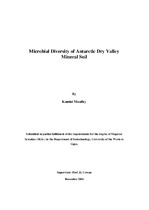Microbial diversity of Antarctic Dry Valley mineral soil
| dc.contributor.advisor | Cowan, D. | |
| dc.contributor.author | Moodley, Kamini | |
| dc.contributor.other | Dept. of Biotechnology | |
| dc.contributor.other | Faculty of Science | |
| dc.date.accessioned | 2013-07-02T06:31:22Z | |
| dc.date.available | 2007/04/18 09:37 | |
| dc.date.available | 2007/04/18 | |
| dc.date.available | 2013-07-02T06:31:22Z | |
| dc.date.issued | 2004 | |
| dc.identifier.uri | http://hdl.handle.net/11394/1596 | |
| dc.description | Magister Scientiae - MSc | en_US |
| dc.description.abstract | Antarctica provides some of the most extreme environments on earth. Low temperatures, low water availability and nutrient deficiency are contributing factors to the limited colonisation of Antarctic biotopes, particularly in the continental Dry Valleys. The survival of microorganisms in this harsh continent provides the basis for the significance of this study. This study aimed to explore microbial phylotypic diversity across a 500 m altitudinal transect in the Miers Dry Valley, Ross Desert, East Antarctica. The study also attempted to infer from phylogenetic data, the possible presence of indicative phenotypes which might contribute to a functional microbial community. | en_US |
| dc.language.iso | en | en_US |
| dc.publisher | University of the Western Cape | en_US |
| dc.subject | Soil microbiology | en_US |
| dc.subject | Microbial ecology | en_US |
| dc.subject | Antarctica | en_US |
| dc.title | Microbial diversity of Antarctic Dry Valley mineral soil | en_US |
| dc.type | Thesis | en_US |
| dc.rights.holder | University of the Western Cape | en_US |
| dc.description.country | South Africa |

